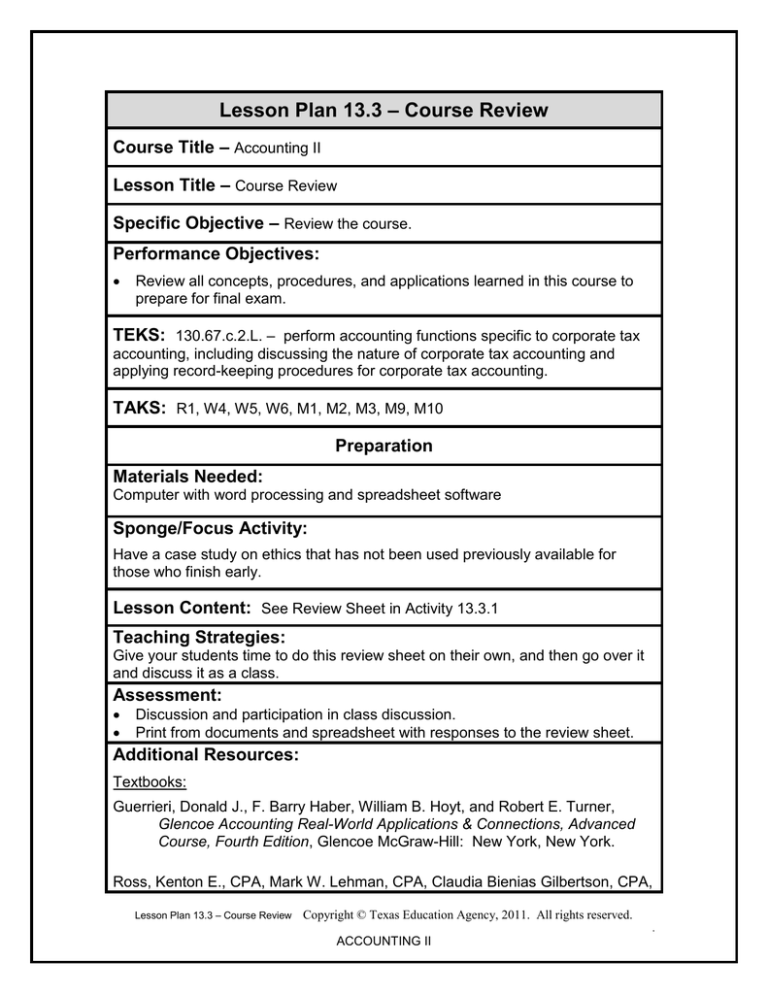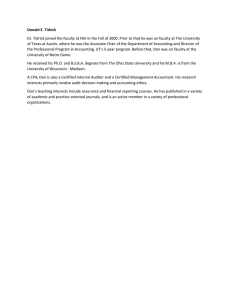– Course Review Lesson Plan 13.3 – Course Title
advertisement

Lesson Plan 13.3 – Course Review Course Title – Accounting II Lesson Title – Course Review Specific Objective – Review the course. Performance Objectives: Review all concepts, procedures, and applications learned in this course to prepare for final exam. TEKS: 130.67.c.2.L. – perform accounting functions specific to corporate tax accounting, including discussing the nature of corporate tax accounting and applying record-keeping procedures for corporate tax accounting. TAKS: R1, W4, W5, W6, M1, M2, M3, M9, M10 Preparation Materials Needed: Computer with word processing and spreadsheet software Sponge/Focus Activity: Have a case study on ethics that has not been used previously available for those who finish early. Lesson Content: See Review Sheet in Activity 13.3.1 Teaching Strategies: Give your students time to do this review sheet on their own, and then go over it and discuss it as a class. Assessment: Discussion and participation in class discussion. Print from documents and spreadsheet with responses to the review sheet. Additional Resources: Textbooks: Guerrieri, Donald J., F. Barry Haber, William B. Hoyt, and Robert E. Turner, Glencoe Accounting Real-World Applications & Connections, Advanced Course, Fourth Edition, Glencoe McGraw-Hill: New York, New York. Ross, Kenton E., CPA, Mark W. Lehman, CPA, Claudia Bienias Gilbertson, CPA, Lesson Plan 13.3 – Course Review Copyright © Texas Education Agency, 2011. All rights reserved. . ACCOUNTING II Robert D. Hanson, Century 21 Accounting Advanced, Anniversary Edition, Thomson South-Western: Mason, OH, 2003. Takin’ Care of Business, Education Handbook, American Institute of Certified Public Accountants, 1211 Avenue of the Americas, New York, NY 100368775, www.aicpa.org. Websites: Accounting II Frameworks from www.txbusinesseducation.org Lesson Plan 13.3 – Course Review Copyright © Texas Education Agency, 2011. All rights reserved. . ACCOUNTING II Activity 13.3.1 – Review Sheet Course Title – Accounting II Lesson Title – Review Sheet Specific Objective –.Review all concepts, procedures, and applications learned in this course to prepare for final exam. TEKS: 130.167.c.2.L. - perform accounting functions specific to corporate tax accounting, including discussing the nature of corporate tax accounting and applying record-keeping procedures for corporate tax accounting. TAKS: R1, W4, W5, W6, M1, M2, M3, M9, M10 Preparation Materials Needed: Computer with word processing and spreadsheet software Teaching Strategies: Give your students time to do this review sheet on their own, and then go over it and discuss it as a class. Activity Outline: Students complete the following review sheet: Accounting II Review Forms of Businesses 1. Identify the characteristics of business organizations and list three advantages and three disadvantages of each: A. Sole-proprietorship B. Partnership C. Corporation D. Limited Liability Corporation E. Limited Liability Partnership F. Non-profit organizations G. E-commerce Accounting Careers: 2. List the educational requirements, skills required for, and the duties of these accounting positions: A. Accounting Clerk Activity13.3.1 – Review Sheet Copyright © Texas Education Agency, 2011. All rights reserved. ACCOUNTING II B. C. Accountant Accounting Manager 3. Describe the differences between working in Private Accounting and Public Accounting. (see - CPA: www.aicpa.org/edu/index.htm, www.tsbpa.state.tx.us, and www.accountingstudents.com) 4. List the educational requirements, skills required for, and duties of a CPA. 5. List the requirements to sit for the CPA Exam. 6. List the requirements to pass the CPA Exam. 7. List some tips for taking the CPA Exam. 8. What does it mean to a CPA? Concepts of Accounting: www.nasd.com/glossary/a.html 9. Explain each: A. Accounting period cycle B. Adequate disclosure C. Business entity D. Consistent reporting E. Going concern F. Historical cost G. Matching expenses with revenue H. Realization of revenue I. Unit of measurement J. Materiality 10. List the Generally Accepted Accounting Principles (GAAP) 11. What is the National Advisory Board? Accounting Ethics: 12. Research Professional Ethics on the Internet, read at least three current articles, and word process a one-page report summarizing your readings. Include all three web sites at the end of your paper. 13. Define each of these professional codes of ethics A. The accountant will not participate in conflict of interest. B. The accountant will keep accounting information confidential and private C. The accountant will be honest D. The accountant will not knowingly break the law. E. The accountant will not practice coercion. F. The accountant will certify the financial statements are accurate. Financial Accounting Applications: 14. List and describe the steps in the Accounting Cycle. Activity13.3.1 – Review Sheet Copyright © Texas Education Agency, 2011. All rights reserved. ACCOUNTING II 15. What is a partnership agreement? See Glencoe Accounting Advanced Course. 16. What is the journal entry for the initial investment of a partnership? 17. When does dissolution of a partnership occur? 18. What transactions are involved in the dissolution of a partnership? Include accounts debited and credited. 19. What does liquidation mean? 20. What transactions are involved in liquidation? Include accounts debited and credited. 21. Describe each of these divisions of profits and losses: A. Sharing based on stated fraction B. Sharing based on partners’ capital contribution C. Sharing based on capital contributions and service to partnership D. Sharing based on salaries and interest 22. Define these terms: A. Board of directors B. Articles of incorporation C. Charter D. Common stock E. Preferred stock F. Stock certificate G. Par value H. Par-value stock I. No-par-value stock J. State-value stock K. Subscribing for capital stock L. Organization cost M. Intangible assets N. Declaring a dividend O. Date of declaration P. Date of record Q. Date of payment R. Stock split 23. Create two transactions for the declaration and payment of dividends; analyze the transactions and show, using T-accounts, the debit and credit parts of the two transactions. 24. Define the follow terms related to the purchase and sale of bonds A. Mortgage B. Bond C. Bond issue D. Underwriter Activity13.3.1 – Review Sheet Copyright © Texas Education Agency, 2011. All rights reserved. ACCOUNTING II E. Bond certificate F. Bond indenture G. Leverage H. Term bond I. Serial bond J. Registered bond K. Coupon L. Secured bond M. Unsecured bond N. Contract rate O. Market interest rate P. Face value Q. Premium R. Discount S. Carrying value T. Amortize U. Callable bond V. Call price W. Sinking fund X. Maturity Value 25. Describe the Vertical Analysis of income statement and balance sheet and the Horizontal Analysis of income statement and balance sheet. 26. Create a spreadsheet with the following financial statement analysis figures including a column for the purpose and the formula. Include: A. Rate earned on average total assets B. Rate earned on average total stockholders’ equity C. Rate earned on net sales D. Earnings per share E. Price-earnings ratio F. Accounts receivable turnover ratio G. Merchandise inventory turnover ratio H. Working capital I. Current ratio J. Acid-Test ratio K. Debt ratio L. Equity ratio M. Equity per share N. Quick ratio 27. Explain the different between Cost Basis and Accrual Basis Accounting Systems. 28. Define and explain how to calculate the inventory using these methods: A. Specific Identification B. FIFO Activity13.3.1 – Review Sheet Copyright © Texas Education Agency, 2011. All rights reserved. ACCOUNTING II C. LIFO D. Weighted Average 29. What happens to financial statements if the inventory figures are inaccurate? 30. What effect can rising and falling prices have on inventory calculations? 31. Explain the motives for choosing each inventory calculation method—FIFO, LIFO, and weighted average. 32. Go to www.irs.gov/taxi, scroll to the bottom and click on Tax Terms. Define these tax terms. A. Business Taxes B. FICA C. Form SS-4 D. Form W2 E. Medicare F. Payroll Taxes G. Sales Taxes H. Taxes I. Transactions Taxes J. VITA 33. Define a voucher system and describe the components of a voucher system. Management Accounting Applications: 34. What are the five basic principles of budgeting? 35. What are the two most common budgets used in business? 36. How is a manufacturing business different from a service or merchandising business? 37. What are the three elements in cost of manufactured product? 38. How is the worksheet different for a manufacturing business? 39. How are the financial statements different for a manufacturing business? 40. Define these terms related to cost accounting: A. Responsibility accounting B. Direct expense C. Indirect expense D. Departmental margin E. Departmental margin statement 41. Define these terms related to cost-volume profit relationship: A. Variable expenses B. Fixed expenses Activity13.3.1 – Review Sheet Copyright © Texas Education Agency, 2011. All rights reserved. ACCOUNTING II C. D. E. F. G. Mixed expenses Contribution margin rate Sales dollar breakeven point Unit Sales Breakeven Point Breakeven Point Income Statement 42. What are the determining factors in making pricing decisions? 43. Complete What-if scenarios. Complete the end-of-period work for a corporation. (Find a comprehensive end-of-period problem for a merchandising corporation that your students have not done. Include a Work Sheet, Financial Statement, Adjusting and Closing Entries, and Post-Closing Trial Balance). Assessment: Quality Feature Discussion Documents Spreadsheets Score 30 40 30 Total 100 Students submit their documents and spreadsheets Activity13.3.1 – Review Sheet Copyright © Texas Education Agency, 2011. All rights reserved. ACCOUNTING II



